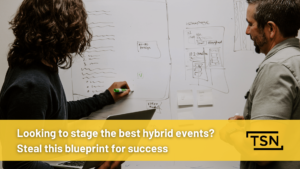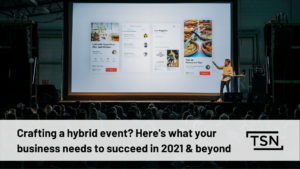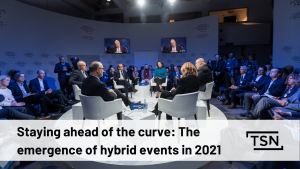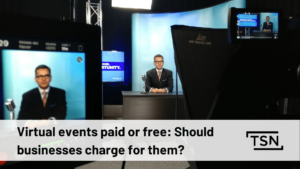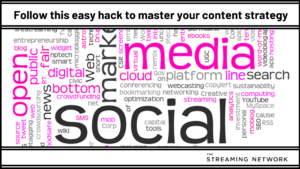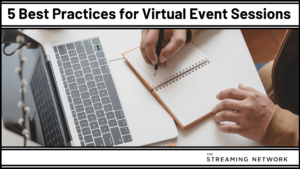Podcast: Play in new window | Download | Embed
Subscribe: Apple Podcasts | Google Podcasts | RSS
Lessons From The Frontline
In this episode of Lessons From The Frontline, we will be talking about moderators.
The use of a moderator in your webinar program allows for a 2-way discussion rather than having 1 speaker talk to the audience the entire time.
You can see examples of leveraging moderators in our Better Webinar series and podcasts.
We will be covering the following topics during today’s podcast:
- If you choose to moderate a webinar yourself, how do you begin this process?
- What is the primary role of the moderator in a webinar? Do they do more than just lob questions at the experts?
- What are the best tips or tricks to moderating? Preparation is key!
- As a moderator, what can you do to make your subject matter expert comfortable? Be aware that some people might freeze when being interviewed.
- How many questions should a moderator ask during a webinar? Keep in mind time constraints.
The Complete Video Transcript
Pete Vamos: Welcome to LFTF, the podcast for webinar nerds. With me is the number one webinar nerd, Matthew Ley, President of The Streaming Network. As always, welcome.
Matthew Ley: Hi. Thank you for having me, Pete. Nice to be back in your basement after a few weeks or months–depending on the distribution of this–that we haven’t, but–.
Pete Vamos: –We’ve been out of here for a while.
Matthew Ley: Yeah, I guess webinar nerd would be the Canadian equivalent of what they’re doing down in San Francisco at , the Webinerd. But, thank you for the kind words.
Pete Vamos: It’s patented.
Matthew Ley: Patented.
Pete Vamos: Webinerd–we’re not allowed to use webinerd.
Matthew Ley: Trademarked, yeah. I don’t know.
Pete Vamos: So, Matt, what I’ve got written here is moderator.
Matthew Ley: Right.
Pete Vamos: The word moderator.
Matthew Ley: Yeah.
Pete Vamos: Tell me, what do we want to talk about today around the subject of moderator?
Matthew Ley: Well, we’ve been promoting the idea that having a moderator in your webinar is a good idea for a long time. And we’ve been showing this and demonstrating it through our Better Webinar series and events like this where there is this back and forth between a moderator or a host and a subject matter expert because we believe that it’s a more–and we have some data that indicates it’s a more engaging webinar format.
But, in general the sole presenter on a webinar is a near-impossible job to do. And it can be done through technology. And it’s feasible, and it happens every day, but it’s an impossible job to do it really, really well. And so, most people have some level of a moderator in. And when they look at what we do, they’re like, “That’s great, we want to do that.” And they’ve got two options, hire a moderator like myself that costs you money–maybe even go a step further and go to like Speakers’ Spotlight or one of those websites and hire a moderator who is more expensive than I am and bring them in–which increases the budget and is not easy for people to do when they’re running lots and lots of webinars–or hire someone internally who becomes the webinar moderator. Often that is you, Mr. Marketing or Miss Marketing Manager, who has the webinar program. And you have to do the moderation side of it.
Pete Vamos: If it’s your idea, you’re probably running with it.
Matthew Ley: Yeah. What I see a lot, too, is the person who is like–they’ve got like–even like they are in their console building it. They are the ones who like, the webinar comes in–they’re the ones who have to run it. And then, they are also tasked with moderating what’s going on.
And regardless if that’s what it is or you’re the person who they feel is the most charismatic or the best to be the moderator, you have not done it before. We’ve written a bit on it, but I thought that it was time to really unpack this entirety of the process of being a moderator.
Pete Vamos: Right.
Matthew Ley: And I got to start with that question that you started with, which I love–that’s a question that I often ask–like why are we talking about this today is what you asked me.
Pete Vamos: Yeah.
Matthew Ley: So, I explained it. And the truth is is that when we come up with our topics, it’s a combination of things I think we should talk about because I hear it on the street. You and our agency work together on a content plan.
But, in the end, the best person to answer that is the person–the thought leader on the other side of the table. And I know you’ve all done this. I’ve seen it. I’ve done it myself, where you’ve got–the biggest part about being a moderator you think is getting that massive intro out where you have to give housekeeping items, what we’re going to talk about today, why we’re here–and all the importance.
And you talk for like three or four minutes, breathe a collective sigh of relief, hand it over to the subject matter expert, who then goes through their 45 PowerPoint lens. So, I find that it’s better to ask that question, have the person answer it–so that you can handle all of the logistics around it–and hear from the horse’s mouth, if you will, why this topic is important. It comes across a lot better.
Pete Vamos: Right. So, let’s say you do choose–rather than to farm it out, bring somebody else in.
Matthew Ley: Yeah.
Pete Vamos: But, you choose as the head of marketing or whatever your position–.
Matthew Ley: –Yeah–.
Pete Vamos: –To take this task on yourself. You need to start from someplace.
Matthew Ley: That’s right.
Pete Vamos: So, what do you need to be thinking about right from the get-go when you begin this process?
Matthew Ley: Well, if you’re in the marketing department, it should be easy for you because you want to think about, what is the objective of this webinar, right? Is the objective–is it your thought leadership series, and the objective is driving leads? Is it a more strategic webinar where you are speaking to existing customers about new products or you’re deep in the consideration stage?
Whatever that might be, you’ve got to keep that in mind always because the presentation needs to speak to that outcome if you’re going to have the goals that you want. And the goals that you want are not simply just getting people to watch but to have that impact pipeline impact the business of your marketer.
So, you want to start with that and make sure that you’ve got that lens on every question you ask–every interpretation from the presenter of what they’re talking about.
On the flip side, after you’ve done that you’ve also, as a marketer, likely gone through your–the persona of the audience, who you’re targeting in this case. Is it a user, buyer? Is it a decision-maker? Is it a team collective? Who is going to be coming to it?
And so, you got to keep their–the lens of who they are in mind. And what I mean by that is as a marketer inside of an organization, especially if you’ve been there for a while, you’ve forgotten more about this topic than your audience knows.
And so, it can be quite easy for two people in the same organization to start talking about a topic and throw around acronyms that the audience doesn’t understand, talk about history that means nothing to them–oh, and past iterations of our platform, “We had this problem.” That doesn’t matter to these people probably, you know–and try and think about it from the way that they’re thinking.
So, one of my recurring gigs as a moderator is with Autism Ontario. And I’ve been doing it for four or five years now. So, I know more about autism spectrum disorder and what’s going on in Ontario than someone off the street, but I am by no means an expert. I am not a clinician. I do not have a family member on the spectrum that I can even give that. So, the lens I give there is the parental lens. We have lots of parents on the call. And so, when I hear a term or they say something, and they brush past it, I just go, “Well, what are we talking–what’s that? Why does that matter?”
Pete Vamos: Good.
Matthew Ley: Do you know what I mean? And I try and always consider the people on the other end to make sure that they get the most out of it. And in a B2B marketing webinar like we have today–or this type of topic–you’ve always got to be thinking about, who is that person on the other side?
Pete Vamos: Taking their perspective.
Matthew Ley: Taking their respective.
Pete Vamos: You know, who your audience–know who your audience is.
Matthew Ley: Right.
Pete Vamos: And listen through the–.
Matthew Ley: –And listen–.
Pete Vamos: –Filter–.
Matthew Ley: –Try and change your mindset to their filter. And that even means, like I said, if you’ve got a multifaceted approach and your webinars are targeting like that user buyer versus a, you know, decision-maker with budget. And we know when we’re selling to them we have to do it differently. You’ve got to speak their language, right?
So, I’m assuming today that I’m primarily talking not to the decision-maker, budget, VP of marketing–that I am talking to that person who has been given the entire webinar program to manage. It’s important, it drives leads, their job is webinar, webinar all day. And they look around the marketing department, there’s five social media graphic design writers, and they are the only one in webinars. And they want to do this better to make it better.
Pete Vamos: Yeah.
Matthew Ley: That’s who I’m talking to. If you’re not that, then hopefully you still get something out of it.
Pete Vamos: Hopefully. Let’s break it down a little bit–.
Matthew Ley: –Sure–.
Pete Vamos: –In terms of the primary roles. Your moderator–you know, it’s not–it’s more than just lobbing questions. It’s–you know, you can’t just throw a question and go get a coffee.
Matthew Ley: No.
Pete Vamos: What are the primary–?
Matthew Ley: –Well, you can, I think, in some cases.
Pete Vamos: It depends on how much the subject matter expert wants to talk, I guess. Yeah.
Matthew Ley: Yeah, they usually do want to talk a lot.
Pete Vamos: Yeah.
Matthew Ley: So, your number one thing is keeping your subject matter expert on point.
Pete Vamos: Yeah.
Matthew Ley: So, they are here as an external who’s got a great wealth of knowledge, who maybe doesn’t know your audience as well, so you got to make sure that that’s in place. They will talk forever about the subject that they’re on because almost everybody who is asked to present on a webinar knows so much more than what they’re going to be talking about, and so time management is a huge thing.
And so, as a moderator your job generally is to ensure that the audience knows how to ask questions and engage with the platform regardless of what platform you’re on, to manage time well, so that you have room for Q&A because if a person engages, they want a response.
The more questions you can answer, the better the audience who is on that webinar is going to feel. They are going to have a higher perception of the value of the webinar. And your job is to make sure that the primary objectives and messaging is always being handled. So, you’ve got to be engaged, you’ve got to be listening.
Pete Vamos: Yeah.
Matthew Ley: Even if you don’t subscribe to our model of question, answer, question, answer, you still have those same objectives in mind. And if you see it going awry, like we’re, you know, almost halfway in, and we haven’t gotten through all of our questions, you’ve got to start speeding up the host–.
Pete Vamos: –Right–.
Matthew Ley: –Or, sorry, the speaker. Or you’ve got to redirect maybe where they’re going with it. And that is your job.
Pete Vamos: Right. And there’s nothing wrong with a moderator also being a subject matter expert and having like a real sort of engaged conversation, but one person needs to be the point person on the meeting, right?
Matthew Ley: There’s nothing–yeah, there’s nothing wrong with it, but I have seen it turn into a bit of a confusing experience.
Pete Vamos: Right.
Matthew Ley: Right? So, sure, when Peter Mansbridge would interview Justin Trudeau, and he could talk about past experiences with John Kashian (SP) or something like that, he had something to offer the conversation.
Pete Vamos: Yeah.
Matthew Ley: But, he’s not the–he’s not going to sit there and, you know, talk for 45–or for 30 minutes or 20 minutes–on a topic.
Pete Vamos: Right.
Matthew Ley: He can’t do that, right? And so–worry about that. I’ve seen–it happens in legal quite a bit, where the practice group leader becomes the host because they’re the practice group leader, and they know more than everyone on that side of the desk. And then, you end up having them, you know, ask questions and then answer them later–.
Pete Vamos: –Right–.
Matthew Ley: –Better or something like that. So, I would caution. I like going in knowing the bare minimum–.
Pete Vamos: –Right–.
Matthew Ley: –That I need to know to get the job done. And I think I do a better job that way.
Pete Vamos: Just lob the questions, and let the experts talk.
Matthew Ley: Yeah, lob the expert.
Pete Vamos: Yeah.
Matthew Ley: Let them talk. Listen, learn while you’re there–nothing more engaging than if you’re actually learning on the other side, and you have an aha moment in the middle of the webinar that you didn’t see coming.
Pete Vamos: Yeah.
Matthew Ley: The authentic-ness of that in an interview, you know, is going to resonate with the audience.
Pete Vamos: For sure, for sure. Let’s dig in a little bit on–you know, there’s tips and tricks to doing this thing.
Matthew Ley: Yes.
Pete Vamos: Let’s share with the audience some of those tips and tricks.
Matthew Ley: Yeah. So, first off, you do the research, and you’ve got the objectives in front of you. You know what it is that you’re going to do. And then, you should have a pre-call with the presenter. And the things that I like to ask in the pre-call–the most important things–are how is this presentation generally given, because if it’s generally given as a webinar, that’s good because they understand the medium.
But, oftentimes you’re taking a presentation that’s usually done either one-on-one or in front of a live audience, where there’s interaction and feedback in a different way. So, understanding that I find is important, so that we can help shape it–towards it.
The other thing–the important thing about the pre-interview for me is always making sure that they don’t come to the table with way too much because they will go deep. Sometimes a presenter will be ready to go really deep on an aspect that there’s just not going to be time in the webinar for or isn’t relevant to the audience. You want to dissect that a little bit.
So, what I do is I sit down with them, and the first thing I say is, “If people walk away with one message from your topic today, what is that message? What do you want to make sure that we get across?” And whatever that answer is, then I let them know, “This is what we want to get across, this is what our audience wants to know.” And that sets a framework of how both sides are going to take this great presentation and translate it to this audience.
Pete Vamos: Right.
Matthew Ley: And then, what I do is I don’t run through the whole thing, but I usually–there’s always a PowerPoint deck. Everyone has got one. We start flicking through it. What do you mean on this slide, why do you do this, what’s that about? And I try and get my head around what–you know, how they’re going to be building their story.
And the last thing that I do–using the word story–is one of the most compelling ways to articulate your message in the webinar format or in any media is by telling a story. And many presenters don’t do that.
And so, I–when I’m hearing these great data set points or these really–things–I’m like, “Can you tell me a real-life story about how that works? Can you work into that a real story that is relevant to it,” and trying to get them into that idea of a narrative. So, there’s a bunch that happens in that pre-meeting, but it’s important so they become comfortable with you and all that.
Pete Vamos: Right.
Matthew Ley: The next step would be making sure–if you are the moderator–it’s good coming from you because they have to have a level of trust with you in this process–that you let them know what’s going to happen on the day of.
If it’s in-studio, I say, “Look, you’re going to come in here two hours early, we’re going to spend a half and hour on the desk, and we’re going to review everything we just reviewed. Then, we’re going to go have coffee, and we’re going to chat, and we’re going to get relaxed. And then, we’re going to come back in and sit down, and we’re going to do it.”
When we come in the room, I’m like, “Okay, you’re going to have, you know, two people in the room, they’re going to be silent the whole time. You don’t got to worry about the cameras.” So, I go through all that.
The same thing has to happen even on audio webinar or a webcam webinar when it’s remote. When are you going to be connecting, what happens if something goes wrong, what am I going to do if it does–and letting them know so that they have zero surprises.
Pete Vamos: Right.
Matthew Ley: You want them comfortable, you want that experience like–I’ve never been on Letterman, or whatever–but, you know, they’ve got the green room where they’ve got the type of thing they like in it, and someone is telling them they’re going to be going on. You want to give them that experience, so that they can come out and do the best job possible on the webinar.
Pete Vamos: So, it sounds to me like you’re recommending, don’t do it on the fly. Is that–but people do.
Matthew Ley: Yeah.
Pete Vamos: And people can.
Matthew Ley: Yeah.
Pete Vamos: But, generally what you’re saying is, you should be prepped. But, can you do it on the fly? Can you moderate on the fly?
Matthew Ley: Well, I think that–I think, like anything, if you do something–.
Pete Vamos: –Not that we’re–.
Matthew Ley: –We’re not.
Pete Vamos: We’re not–that’s not what we’re doing here.
Matthew Ley: Never. Never you and me. Well, I think that with like–well, let’s just talk about that, right?
Pete Vamos: Yeah.
Matthew Ley: Like we–you know, I got caught up before this. I provide–I usually feed you some of the stuff for this–surprise, surprise.
Pete Vamos: Yeah.
Matthew Ley: And I wasn’t able to do that, so we did an escalated version of prep on this. But, we’ve done–I don’t know, what are we–40 of these together?
Pete Vamos: Yeah.
Matthew Ley: We work together every day. We’ve done these, we’re in the industry. So, yeah, we can do that. And once–like anything, once you, you know, have an efficient process, and you know all the steps, you can condense those steps.
Pete Vamos: Yeah.
Matthew Ley: I just think that you shouldn’t–that you probably spend a lot of time worrying about what your e-mails are going to say and when they are going to drop and what this looks like and the changes to the console, or to whatever in your webinar, that this part of it probably gets overlooked because you’ve got this great presenter, and they’re going to do amazing.
And I think that you should spend more time with it because the more time you spend with it, I find it morphs, and it changes, and it’s usually for the better because you’re having a dialog that’s open and honest about what you both want to accomplish or what the audience does. And the more that people hear it, it can morph from this great presentation you saw at a conference–and now you want to do on a webinar–to a great webinar. And that, I think, is the crux of it. So, I would just say don’t rush it, always take the time and do it right.
Pete Vamos: Right. It’s interesting because being–as a moderator or as a host, you know, one of the things–you’re kind of the therapist, kind of the bartender, right?
Matthew Ley: Yeah.
Pete Vamos: You’ve got to–you need to come in and have the role of putting the person at ease because you’re obviously comfortable doing this sort of stuff.
Matthew Ley: Yes.
Pete Vamos: But, that’s not always the case, right? You have people who have loads of knowledge.
Matthew Ley: Yeah.
Pete Vamos: As soon as the camera starts rolling, all of a sudden they just–they tense up, and they become a little–so, the moderator really has to be aware of that as well and help them navigate through that, right?
Matthew Ley: Right. And, I mean, everything is fine when nothing goes wrong, right? So, I was on the desk not too long age moderating an event and did not have it in my calendar–straight-up forgot it was happening–was not–did not have a pre-call, don’t believe it was booked. I’m sure it was–and missed it.
But, they trusted the–the company trusted me, so it went. And I had a presenter on the desk who I’ve interviewed four times, and he had brought with him a colleague who has never been there before. She was great. But early on, because I hadn’t done my pre-work, I was struggling with what the audience was going to get out of it, like it did not seem–I didn’t understand how it was going to resonate. That was because I asked some key questions. And they had what felt like way too much content.
Pete Vamos: Right.
Matthew Ley: So, I’m trying to stick handle that in that little hour before while making them comfortable, and we walked out of it. I said, “We have to get off, we have to talk to the client who hired me.” And we walked out. And the girl, I could see, was almost in tears. I had scared the shit out of her with the way I had done that.
And that was me not being fully prepared. So, as comfortable as I am, afterward she thanked me, “Oh, it was good. I can’t believe it was so good. I was so nervous going into it.” I’m like, “That’s my fault. You probably wouldn’t have been if you had come through the regular process.”
So, it can happen to the best of us. And if you’re not–if you’re stumbling with the technology, or you’re uncomfortable, or you don’t have it, it’s going to make the person on the other end not deliver, for sure.
Pete Vamos: Right. The–you know, one of the questions–and we didn’t talk about this before–but, how many–you know, I’ve got a rule of thumb in terms of how many questions we ask.
Matthew Ley: Yeah, yeah, yeah.
Pete Vamos: I’ve asked six questions, and we’re 20–basically 20 minutes into this thing.
Matthew Ley: Yeah.
Pete Vamos: When you’re doing a webinar, you kind of have a finite amount of time.
Matthew Ley: That’s right.
Pete Vamos: What’s the rule of thumb, like what do want to go in with in terms of number of questions?
Matthew Ley: So, in a one-hour webinar, and I’m–it’s my whole math (SP) that I’m going to have to look up–but it will have the link to it. But, in a one-hour webinar, I say the most questions that can be asked are 24. And by that I mean you’ve got your intro, you’ve got your stage questions, and then you have to have room for audience questions. These events are supposed to be 20 to 30 minutes–and the idea that we could run them as a webinar, and the rest of that time would be answering our audience questions.
So, when you start thinking about the fact that you’re going to ask a certain amount that are completely staged to the PowerPoint, then you’ve got your flier questions that you work out, which are usually questions that you want to have answered as a business that may or may not get asked, and then you got to answer real questions. As good or bad as they are, you got to answer real questions. Twenty-four would be the most.
Pete Vamos: Right.
Matthew Ley: So, I wouldn’t plan for 24. I would plan for 8 to 10 questions, that you get you through your content, have a backup list of four or five in case you have an inactive audience, and then just know that that is going to leave you with this much room when it’s all said and done.
Pete Vamos: You’re going to have to–.
Matthew Ley: –Yeah–.
Pete Vamos: –Potentially think on the fly.
Matthew Ley: Yeah.
Pete Vamos: Okay, that’s great. Are there other things? Are there other things we haven’t covered in terms of the subject because I had (unintelligible) the next steps, but you really talked a little bit about that, but–.
Matthew Ley: –Yeah, yeah, I think that, you know, once you’ve–you got to create your own framework, right? So, you’ve got your number of questions for this show. You know how long-winded I am as well. So, we’ve got sort of a flow, and you’ve got your own framework. From there, it’s about making it your own.
And we watch late-night television for two reasons. We like the host–charismatic, funny, whatever–and the guests that they have on. And so, I’m not saying that in a, you know, webinar about Internet security or castle legislation that it’s about being witty and funny and all that. But, you have your own–you should have your own–you should bring your own personality to what it is you’re doing.
And it’s not easy to do that if you’re worried about, what’s the next question, what’s the next step, or whatever that is. So, once you get out (SP), you want to start thinking about how your personality can be brought in. And the easiest way to do that–whether you’re presenting or you’re a host–is to find a way to be as much yourself as possible. Wear what you wear on a normal day if you’re on camera, and know the things that, you know, people like about you–you know, the reasons you were selected for this–and play into that. Don’t try and be something that you’re not, right?
So, we have very different moderation–not very different–we have different moderation styles. We’re different. You have an understated kind of self-deprecating funny that you do. I am a more over-the-top sort of verbose–whatever. It wouldn’t work–well, it might–but it would take some time for you to try and do it like me. And if I tried to do it like you–.
Pete Vamos: –Yeah–.
Matthew Ley: –It would feel weird.
Pete Vamos: Yeah.
Matthew Ley: Yeah, people wouldn’t know what they were getting. So, try and bring personality to it. Remember, these people have given you an hour of their time. Your job is to ensure that you–and this might be our moment of zen–but, your job should be to ensure that you’ve (unintelligible) on the promise of the webinar promotion, you will learn how to moderate a webinar, and that they leave saying, “That was fun, I got my questions answered, and I learned something.”
And to do that, you know, it takes some time, but once you get there, you get a following, and you’ll knock your numbers out. You’ll knock your numbers out from your leads generated and things like that.
Pete Vamos: So, the last question I actually had here was just moment of zen, and you said, “I’ll come up with it.”
Matthew Ley: Yeah, but I think it just–.
Pete Vamos: –So, the moment of zen was, “Can you come up with a moment of zen?”
Matthew Ley: Yeah.
Pete Vamos: And you came up with a moment of zen.
Matthew Ley: I did. I think I just did that on the fly. Yeah.
Pete Vamos: You watched the moment of zen in real time.
Matthew Ley: Yeah, yeah, and I will mention because this goes out in podcast, or whatever, is that on the blog–that there will be a couple resources. One is the engagement ROIE (SP) book because it takes through–a methodology for turning–if you want to do the Q&A format, there’s a methodology embedded in there for taking the didactic presentation and turning it to a Q&A. And then, there’s another blog post–quite old–but it reiterates a lot of what we said–that you can print off and look at about, you know–so, you are asked to be a moderator, you know, here are some steps sort of printed.
Pete Vamos: Right, right, okay.
Matthew Ley: All right.
Pete Vamos: All right. Well, we only went two minutes over our 20-minute limit.
Matthew Ley: That’s awesome.
Pete Vamos: So, that’s awesome. We actually did it.
Matthew Ley: Yeah.
Pete Vamos: This is LFTF, Matthew Ley. Thank you so much once again.
Matthew Ley: Thank you, Pete.
Pete Vamos: Until next time, we’ll see you again.

